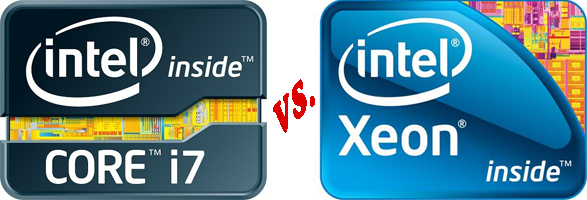Whats the difference between an Intel Xeon and Intel i7 processor?
Published:
In the case of CPUs it is an especially important choice to make since the specific socket and architecture of your chosen CPU(s) will affect all other component choices, such which motherboards are available and what memory you can use. In this post we will be looking at the key differences between the consumer enthusiast Core i7 CPUs and the server and workstation grade Xeon CPUs.

The first thing to get out of the way, is that the main difference between these processor lines is not performance. For all intents and purposes an i7 and Xeon when matched core-for-core and clock-for-clock have essentially the same computational power. That may sound like an open-and-shut case, but the way that CPUs are fabricated points to the first important difference between these CPU lines. When CPUs are mass produced they are quality checked and sorted into different bins. It is often the case that a particular architecture, because of its complexity and imperfect manufacturing methods, does not produce a very high yield of units that perform close to the theoretical optimum the architecture specifies. So a relatively small percentage of CPUs will test at the top and these become the high-end flagship products. The units that do not match up are often sold as lower specified units. Usually this just means setting the standard clock lower, but it can also mean that some physical on-chip components are also disabled or non-functional. Such as cache memory units or entire cores.
When AMD had yield-issues with some of its Phenom quad-core CPUs a few years ago it cleverly re-branded and resold them as triple cores, with the faulty core disabled. As a particular architecture matures yields go up, which means that in some cases perfectly good higher-end CPUs are artificially crippled to feed certain market sector demands. That is why some generations of chips have become legendary for their low price, but high overclocking potential. In some cases entire cores could be reactivated, giving you a free quad-core when you paid for a triple.
This is the key difference between the i7 and Xeon CPU lines. Xeons have a much more stringent set of parameters to adhere to in order to be binned as such. While i7 CPUs are binned for their performance characteristics, Xeon CPUs are binned for low-voltage and high-stability characteristics. Xeons are chosen for their ability to run 24/7 in enclosed server rackmount environments. Less voltage for a given clock speed means less heat and of course less electricity. Core i7 CPUs go into well ventilated high end PCs where the extra heat and power is not that much of a consideration. The Xeons also lack the on-die GPU of some of the i7 series, which further improves its thermal characteristics.
Xeon CPUs also support server-grade buffered ECC RAM, which has built in error correction hardware that normal desktop RAM lacks. If you matched this RAM with an i7 it would not even boot. ECC RAM is important where accuracy is mission critical, such as precise research applications, or where stability is essential. In any event, an i7 CPU will only accept up to 64 GB of unbuffered RAM, whereas a Xeon will take 512 GB+ of fully buffered ECC RAM.
Another very important factor is that only Xeon CPUs will work in multi-socket configurations, which means that only those chips can give you the maximum number of CPU cores in one PC.
Since Xeons are top-binned products the newest technology often appears there first too. At present Xeons have the only example of 12-core CPUs in Intel's range, with an i7 version sure to follow at some time when yields have become good enough.
Hopefully you will now have a solid understanding of what separates high-grade chips such as the Xeon from consumer grade products such as the i7.
For a great example, check out the TitanUS X650, which is an ultimate multi-threading machine sporting a maximum of 48-cores through a quad-CPU Xeon configuration. There is simply no way to achieve such a build using something like the Core i7